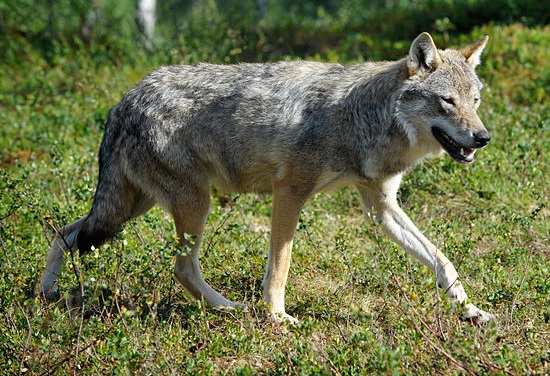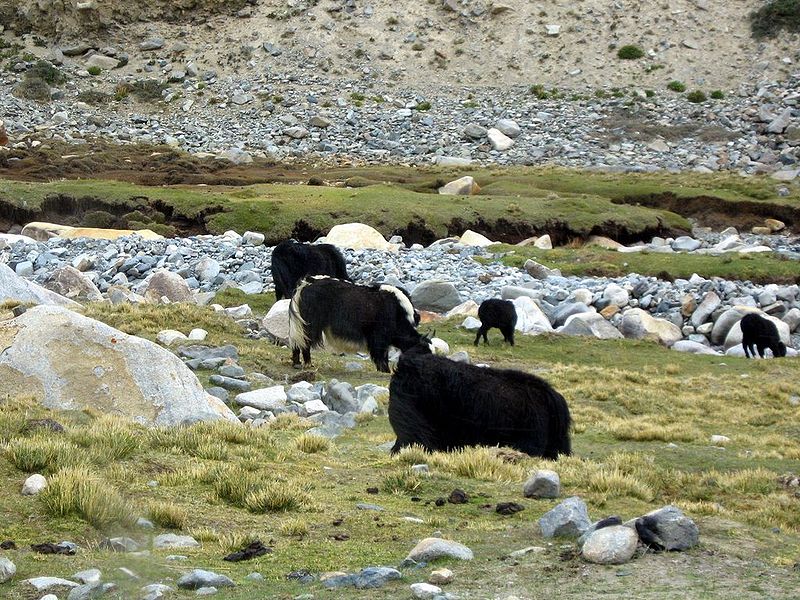Making my way into the park beyond Kungri, about 3 km from Mikim Village (3,600m), I stopped to take in the panoramic view of the westward-flowing Pin River turning north to meet the Paraiho River. And I realised that the name ‘Pin Valley National Park’ was in fact a misnomer. Only a very small portion of the eastern boundary of the park (about 45 km) runs above the Pin River; the major part of the park is actually in the Paraiho River catchment. As we moved along the Paraiho River, the landscape became progressively more desolate and devoid of vegetation. Yet, it was full of grandeur and a unique beauty. The exposed rocks and bare hillsides were a mosaic of different hues. Against the azure sky, the starkness of the scenery stood out clear and proud, and the pure, rarefied atmosphere made for a fitting accompaniment.
Our progress was slow — we took more than 3 hrs to cover the distance of 7 km from Mikim to Kidul Cho, a nullah demarcating the park boundary in the east. (Now the road extends another 21 km to Mudh Village, close to the park boundary.) Namgyal, the park official who accompanied me, told us to walk at a slow pace, and take enough rest in between every two steps to avoid breathlessness. I found it an extremely useful piece of advice, which I’ve since followed while trekking in high-altitude areas. I was also glad I’d halted at Pooh and Tabo along the way — it helped me acclimatise.
Moving about 3 km inside the park boundary, we came across the small settlements of Ka, Minsar, Gechang and Thango, the latter two being temporary summer dwellings. We decided to camp in the meadow close to Thango (3,900m). As the sun started to set, there was a sudden drop in the temperature, and I was glad I was well equipped for the cold, with my alpine tent with double coverings and a down-feather sleeping bag. At many times at night, I felt thirsty, and towards morning, I had to crack open the cover of my frozen water bottle.
I woke up to the sounds of bells of ponies and horses. Namgyal pointed to a deep wound on the neck of one of the horses. The owner, a resident of Guling Village, told us of a jhatpo (the local name for snow leopard) attacking his Chamurthy horse (a local breed) the night before, when it had ventured alone into the Khaminger pasture in the park’s north-central area. Apparently, a jhatpo stalking and attacking sheep and cattle in the cold desert is pretty much a normal occurrence. Unfortunately, that was the closest we got to the snow leopard.
Mid-afternoon, when we were crossing a slow-flowing rivulet before Debsa, to the south-east of Khaminger pasture, Namgyal pointed to a full-grown male tangrol (ibex) standing on a cliff about 200m away. We excitedly scanned the area through binoculars and spotted eight more of them. On another visit, I counted thirty-seven ibex during a 9-km walk in the park. I also spotted a herd of about 20 ibex along with blue sheep above Mudh Village in Pin Valley, just outside the park.
I first visited Pin Valley National Park in 1987 when Tabo had but one small tourist bungalow, and Kaza was just getting ready to receive electricity. Both Indians and foreigners were then restricted from going into Kinnaur and Spiti. But on my next visit, the newly constructed Atargu steel bridge (by the confluence of the Pin- Spiti rivers) had just thrown open the Pin Valley to vehicular traffic.
I love the valley for its naturalness. The interdependence between the locals and their environment is apparent in the sound water management practices that they follow and the way they construct their houses. Subsequent visits have revealed that nothing much has changed; everything that so attracted me on my first trek here is intact — the clearness of the air, the great vistas of the cliffs and gorges, and that sense of freedom that comes with leaving behind the trappings of industrial civilisation.
About Pin Valley National Park
Created in January 1987, Pin Valley National Park stretches over an area of over 675 sq km in the uninhabited areas of the Pin and Paraiho river catchments; altitudes range from 3,500 to 6,000m. The landscape is typically ‘cold desert’ — high-altitude terrain with sparse vegetation — and boasts of fauna and flora characteristic of cold deserts. Pin Valley, along with most of Spiti, receives an annual rainfall of about 17.7 cm; the area does not get any monsoon rains. Western disturbances in winter and spring cause snowfall and the wind chill factor is high even in the daytime in winter. The minimum temperature may go down to minus 32 degree C in January-February. July and August are the warmest months, with temperatures rising to 30 degree C in August.
Herbaceous and shrub growth dominate here. The main woody species is juniper, which has become almost extinct in the park area. Shrubs, which are of the dry alpine variety, include wild rose, sea buckthorn and juniper. There is remarkable variety in the herbaceous vegetation, with columbine, kingcup, potentila and primula being the dominant species. Around 400 plant species are said to thrive in the area, among them many varieties of medicinal plants. In summer, wild flowers create a riot of colours in some areas. The glacial heights of the National Park are devoid of vegetation.
The incidence of grazing of goats, sheep, yaks and other domestic animals in the park is a matter of deep concern. In the prevailing geographical and climatic conditions, the rearing of these animals is indispensable. But what is causing the most damage is not the relatively smaller numbers of sheep and goats owned by the locals, but the large herds of animals brought in by shepherds of the neighbouring district of Kinnaur from June-October. Another area of concern is the collection of firewood. The severity of the winters here necessitates plenty of fuel to keep warm. In summer, locals use their yaks to collect any available plants in the area, often digging out entire plants, roots and all, for use as winter fuel. The process of deciding on the rights of locals is ongoing, and should be completed within the next couple of years, to help curb the pressures on the park.
Spiti’s populace is Buddhist and does not kill animals, resulting in the relative preservation of the wildlife of the area. Large herds of ibex and bharal or blue sheep can be easily spotted; the density of ibex is reported to be 2.29 per sq km. Well known as one of the last remaining habitats of the snow leopard, the park is believed to have 12 members of this highly endangered species. Several other rare and threatened species are protected in the Pin Valley, including the snow partridge and Himalayan snowcock.
Quick Facts
State: Himachal Pradesh
Location: In the Spiti sub-division of Lahaul and Spiti District, in Pin Valley in north-east Himachal Distances 390 km NE of Shimla, 248 km SE of Manali
Route from Shimla NH22 to Sumdo via Narkanda, Rampur Bushehr, Wangtu, Karchham, Spello, Pooh, Yangthang and Chango; state highway to Atargu via Tabo and Poh; link road to Mudh Village via Mikim Route from Manali State highway to Atargu via Kothi, Rohtang Pass, Gramphoo, Batal, Kunzum Pass, Losar, Rangrik and Kaza; link road to Mudh Village
When to go: Late Mar-Jun and Sep-Oct. The park is virtually inaccessible in winter (Dec-early Mar)
Best sightings Apr-May and Nov, when the animals come down to the valleys. Jul-Aug is best for flora
Go there for Ibex, snow leopard, blue sheep, Tibetan wolf, high-altitude flora
Spiti permits Indians don’t need a permit (and foreigners can easily obtain one from Kaza or Rekong Peo) to travel from Kinnaur into Spiti or vice versa
About the Author
Sanjeeva Pandey is the director, the Great Himalayan NP, a hot spot of biological diversity in the western Himalaya. He has been involved in the management of Pin Valley NP and several sanctuaries in Kinaur and Shimla.







